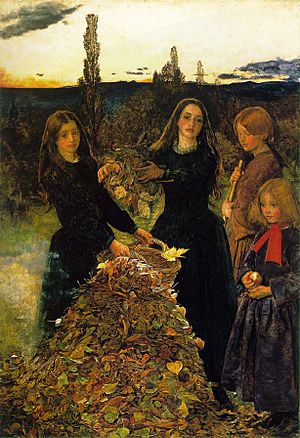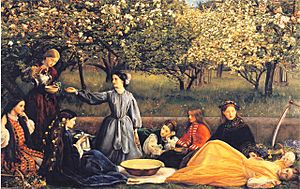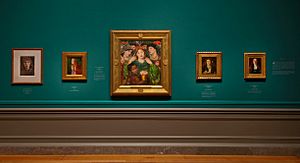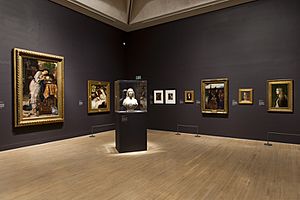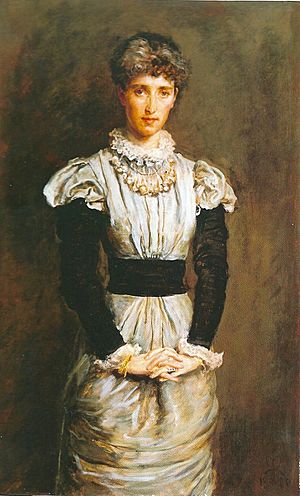Sophie Gray facts for kids
Quick facts for kids
Sophie Gray
|
|
|---|---|

Portrait of a Young Lady, Millais's 1857 painting of Sophie Gray
|
|
| Born |
Sophia Margaret Gray
28 October 1843 |
| Died | 15 March 1882 (aged 38) |
| Nationality | British |
| Known for | Model for the pre-Raphaelite painter John Everett Millais |
| Spouse(s) | James Caird |
| Children | 1 |
| Relatives | Effie Gray (sister) |
Sophia Margaret "Sophie" Gray (28 October 1843 – 15 March 1882), later Sophia Margaret Caird, was a Scottish model for her brother-in-law, the Pre-Raphaelite painter John Everett Millais. She was a younger sister of Euphemia "Effie" Gray, who married Millais in 1855 after the annulment of her marriage to John Ruskin. The spelling of her name was, after around 1861, sometimes "Sophy," but only within the family. In public she was known as Sophie and later in life, after her marriage, as Sophia.
From the late 1860s she suffered from a mental illness which seems to have involved a form of anorexia nervosa. In 1873, she married the Scottish entrepreneur James Caird and together they had a daughter. She died in 1882, probably as a result of her anorexia.
Contents
Background
Sophie Gray was born in October 1843 to Sophia Margaret Gray, née Jameson (1808–1894), and George Gray (1798–1877), a Scottish lawyer and businessman. Her maternal grandfather, Andrew Jameson, became Sheriff-substitute of Fife. Effie Gray (1828–1897), known initially to the family as "Phemy," was the first of fifteen children, and Sophie was the tenth—three sisters, one also named Sophia Margaret, predeceased her. Two of her five elder brothers died before her birth and two passed away before she was seven.
The family lived at Bowerswell, a house re-built in 1842 near the foot of Kinnoull Hill, south-east of Perth. As a child, Gray frequently visited and stayed with her sister Effie in London with her husband, the critic and artist John Ruskin. To an extent Effie, who was fifteen years older than Sophie, acted as a kind of second mother to her and Effie's other siblings.
Effie Gray's flight from Ruskin and marriage to Millais
On 25 April 1854 Effie left her husband on the pretence of visiting her parents in Scotland. Gray had been staying with the Ruskins, at their home in Herne Hill since just after Christmas 1853 and appears to have been complicit in her sister's flight. She and Effie were seen off in silence by Ruskin at the recently opened King's Cross station, where, accompanied by Crawley, they boarded a train for Edinburgh. However, Gray alighted at Hitchin, Hertfordshire where her parents were waiting. Her mother took her place on the train, while she and her father returned to London to deliver a package from Effie to her solicitors. That evening a citation of nullity was delivered to Ruskin, together with certain effects such as Effie's wedding ring and her keys. The following day Gray and her father returned to Scotland by steamer.
Effie was granted a decree of nullity on 20 July 1854. The previous summer, she, Ruskin, and his protégé John Millais had spent four months together in the Scottish Highlands, during which time she and Millais formed a close bond. In early 1854, Millais painted a portrait of Gray for her parents.
After the annulment of her marriage, Effie avoided Millais for some time, although he remained in contact with the girls' mother. Effie and Gray, whose governess was not replaced, spent much of the summer at St Andrews, on the coast of Fife, with their younger sister, Alice Elizabeth Gray (1845–1929). They went for walks together and Effie, who had been well educated herself, acted as her sisters’ teacher. The following year, Millais came up to Bowerswell, where they were married in June 1855.
Gray as model
For the next few years Gray continued to sit for Millais. In the words of art historian Suzanne Fagence Cooper, whose biographical chapter about Gray (2010) provides the fullest account of her life, Gray "changes before our eyes from a child to a stunning teenager." This change can be traced in three works by Millais: Autumn Leaves (1855–56), Spring (or Apple Blossoms) (1856–1859) and, most strikingly, in a small, but "unnerving" portrait of her at the age of 13, entitled Portrait of a Young Lady, or simply Sophie Gray (1857). Charles Edward Perugini also painted a portrait of Gray as a young woman; the date is not known with certainty and for some years it was attributed mistakenly to Millais.
Autumn Leaves and Spring
In Autumn Leaves, Gray is one of four girls beside a smoking bonfire of leaves. Her sister Alice is also in this picture, together with two local girls at the right procured by Effie. Of the four, only Gray appears to be verging on womanhood.
In the later Spring, eight girls (whose ages ranged from 12 to 15) recline in an orchard. Gray is depicted in profile, wearing a colourful, striped robe, with long flowing hair, while Alice lies a somewhat provocatively with a blade of grass in her mouth.
Later works
Unlike Millais's 1854 portrait of Gray, his later work was not kept by the family. It was sold to George Price Boyce, a friend of Millais's Pre-Raphaelite brother, Dante Gabriel Rossetti.
In 2012 Autumn Leaves and Sophie Gray, the latter from a private collection, were displayed alongside each other in Tate Britain's major exhibition of Pre-Raphaelites, Victorian Avant-Garde.
Mental illness and marriage
In 1868 Gray became unwell. It is clear from letters at the time that she was suffering from anorexia nervosa. She also became restless and obsessed with music, especially piano playing. Her speech was often incoherent. In March 1869 Millais wrote to William Holman Hunt that Gray had "been ill a whole year, and away from home, with hysteria."
At the request of the Grays, Millais placed Gray at Chiswick Asylum, Chiswick under the care of Dr Thomas Harrington Tuke (1826–88), a leading practitioner in mental illness. Tuke had treated Millais's friend, the painter Edwin Landseer. Gray lived with the family of one of Tuke's colleagues until she was well enough to move to lodgings in Hammersmith in 1869 and then back to Bowerswell in Perth. Although the state of her health fluctuated, it was to remain a problem for her and a concern to others for the rest of her life.
Marriage to James Caird
On 16 July 1873 Gray married James Key Caird (1837–1916), a Dundee jute manufacturer who had courted her for several years. Caird was disliked by her family, who thought him two-faced and who were still mindful of Effie's disastrous marriage to Ruskin. They would have been aware also that the port of Dundee had, for some time, been taking trade away from Perth. However, attempts to dissuade Gray from going ahead with the wedding were muted by fears of triggering a further collapse of her health.
The Cairds' only child, Beatrix Ada, was born in 1874. The father was notably absent during Gray's confinement, thereby intensifying bad feeling with her family. In 1875, he forbade Gray from staying with Effie on her way to France and, generally, at a time when his business was expanding, he seems to have been both inconsiderate and uncaring towards her.
Final years
During her final years, Gray spent much of her time alone with Beatrix, mostly living between Dundee and Paris. In 1880 Millais painted a final portrait of her, which was exhibited at the new Grosvenor Gallery. The portrait hung in Effie and John Everett Millais's house at Palace Gate, London, and remains in the family.
By the 1880s Gray had become increasingly emaciated (the effects largely hidden from others by the weight of late Victorian clothing), and in 1882 returned to the care of Tuke. She died on 15 March 1882, aged 38. Tuke gave the cause of death as exhaustion and "atrophy of nervous system, 17 years."
Millais painted a lovely portrait of Gray's daughter, Beatrix Caird, in 1879, but she died in 1888 at age 13. James Caird subsequently used his wealth to support Ernest Shackleton's Trans-Antarctic expedition of 1914–1917, and was a significant benefactor to the city of Dundee. He became a baronet in 1913.
Popular culture
In Emma Thompson's film Effie Gray, completed in 2013, Sophie is portrayed by Polly Dartford. Effie Gray is played by Dakota Fanning.


